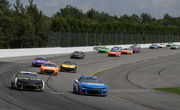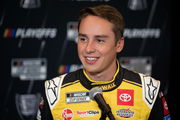
via Getty
DAYTONA BEACH, FLORIDA – JANUARY 30: The #48 Cadillac Dpi of Jimmie Johnson, Kamui Kobayashi, Jose Maria Lopez and Mike Rockenfeller races down the front straightaway during the Rolex 24 during the IMSA WeatherTech Series race at Daytona International Speedway on January 30, 2022 in Daytona Beach, Florida. (Photo by Brian Cleary/Getty Images)

via Getty
DAYTONA BEACH, FLORIDA – JANUARY 30: The #48 Cadillac Dpi of Jimmie Johnson, Kamui Kobayashi, Jose Maria Lopez and Mike Rockenfeller races down the front straightaway during the Rolex 24 during the IMSA WeatherTech Series race at Daytona International Speedway on January 30, 2022 in Daytona Beach, Florida. (Photo by Brian Cleary/Getty Images)
It is finally the ‘Rise of Machines’ in the world of sports. With terms like automation and artificial intelligence becoming everyday buzzwords in the past year, it has also been in vogue on the playing field. While sports like the NFL and NBA have already made leaps into the future by building remote control facilities miles away from the venue, NASCAR is not far away in this game of automation.
However, before NASCAR unveiled its new command center late last year, racing formats like the IMSA WeatherTech SportsCar Championship have already forayed in that direction. To make precise decisions, the sports association preserves its hawk-like vision through its hi-tech command center. Owing to this, motorsports journalist Marshall Pruett, tried to provide an insider’s glimpse inside the tech center, with all the personnel on their toes, ahead of the coveted Rolex 24 at Daytona.
ADVERTISEMENT
Article continues below this ad
Rolex 24 Hours of Daytona’s control room amazes motorsports journalist
It was just a month back that NASCAR unveiled its $53 million, 58,000 sq ft production facility in Concord, N.C. To add to this magnificent structure, the authorities announced their intent to build a remote race control building. This is set to come into operation in the 2024 season itself. However, this doesn’t axiomatically mean a decrease in the presence of race officials on race towers. Rather, it would provide additional resources that would ascertain certain calls concisely and precisely.
This remote command center is already in practice in sports like the NFL, whose command center is based in New York. While NASCAR is steps away from relying on the magic of technology, IMSA’s series on the track of Daytona has already pinned its hopes on the judgment of the personnel present in the control tower of the track, along with other hi-tech paraphernalia. Speaking to the IMSA race director Beaux Barfield ahead of the Rolex 24 at Daytona, journalist Marshall Pruett tried to unearth the functioning of the control room. An awestruck Pruett expressed to Barfield, “You have got this great family, all huddled together. This is like a jazz band, everyone playing their roles, and there’s no improvising.”
Unraveling the various facets of the control rooms and the members associated with them, Barfield stated that the setup remained similar irrespective of the tracks that they visited throughout the year. Whether it was the number of cameras or television broadcasting the race, everything had its own designated location. Pointing to Jim Swintel, Barfield apprised the journalist that the veteran was not only filling the role of a logger but also a red hat. Barfield continued, “And that’s a person that talks directly from race control to the director of TV production.”
Watch this Story: Dale Earnhardt’s Legacy Revived on the Streets
He also pointed out to the communication director and the clerk of the course that play a significant role in the smooth functioning of the race. Moreover, Barfield also revealed that he has worked with this personnel for more than twenty years. The race director also boasted that the members present in the room were more than capable of handling the transition from a red flag to a green flag in a seamless manner. He added, “There is no tension. There is no anxiety when any of that happens.”
The director also shed light on how the replay television functioned and helped in taking certain calls, while David Donohue helped in making decisions from the driver’s standpoint. Moreover, he asserted that there is no verbal discussion among the members, and is completely carried through devices, which shows a perfect blend of human touch and technological inputs.
Trending
ADVERTISEMENT
Article continues below this ad
NASCAR divulges its hopes behind the incorporation of remote setup
While IMSA’s endurance has already paved the way for the technological developments to be incorporated into the sport to deliver an error-free result, NASCAR is yet to walk in the same direction and is making efforts to stay at par with the development in the sports world.
Hoping to see the developments soon, Brad Moran, the director of NASCAR’s Cup Series, expressed as per Sportsnaut, “The ultimate goal is for us to be able to do some remote officiating. There are certain things in the tower we’re going to have to have people on-site but even from a pit road standpoint, we’ve had people down in Charlotte review pit stops and call up race control.”
“So that’s a thing that’s coming down the pipeline. The other part is to also be able to train the next generation of race directors, next generation pit road officials, timing and scoring, all the functions that go into race control. It gives us the ability to build that up.”
ADVERTISEMENT
Article continues below this ad
Read More: Justin Marks’ Trackhouse Racing Unveils 2024 MotoGP Paint Scheme Leaving Racing Fans Starstruck
Having said that, it will be interesting to see how NASCAR gets impacted with the incorporation of the new changes. With the developments awaiting on the horizon, the sport is ready to mark a new beginning.
ADVERTISEMENT
ADVERTISEMENT
ADVERTISEMENT
ADVERTISEMENT






